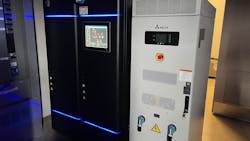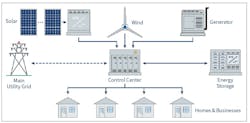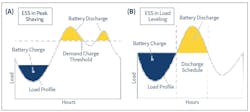In today’s rapidly evolving energy landscape, businesses face increasing pressure to enhance their energy efficiency, reduce costs, and achieve business operations reliability while contributing to sustainability efforts. Two innovative solutions that have gained prominence recently are energy storage systems (ESSs) and microgrids. These technologies not only transform how energy is managed but also the role of energy in a business’s strategy. In this article, we delve into the intricacies of energy storage and microgrids, exploring their unique benefits to businesses and communities and their role in shaping the future of energy consumption.
The basics
Before we explore their applications, let’s get aligned on the basics of what energy storage and microgrid systems entail.
As the name implies, an ESS stores energy to be released for use later. These systems are designed to bridge the gap between energy generation and consumption, enabling excess energy to be stored when demand is low and released when demand is high. Spurred by the Inflation Reduction Act (IRA), battery deployment has grown 300% in the last two years in the United States and is predicted to increase exponentially. The primary equipment in an ESS is the battery and the inverter, which are coupled either externally or within a single form factor to provide grid-level AC electricity.
Although “microgrid” is a buzzword these days, these systems are often not fully understood. The Department of Energy’s definition of a microgrid is:
- An easily identifiable boundary from the rest of the grid.
- Resources within the microgrid are controlled together.
- The microgrid can function whether or not it is connected to the larger grid.
The key components of a microgrid include:
- Energy generation source (solar panels, wind turbines, generators, and others).
- Energy storage systems (most often batteries).
- Load (things that use energy).
Microgrids can be as small as a single building or as large as a whole community (Fig. 1). Microgrids are distinguishable from solely solar-plus-storage systems in that the equipment must have the ability to isolate (i.e., islanding) from the grid (if grid-tied) and manage the power quality (voltage and frequency control), which is usually the grid’s responsibility.
You may be wondering, “Why all the hype around energy storage? And how will this help a community or business?” Let’s take a look at some energy storage use cases to gain perspective.
Energy storage use cases
There are various distinct usages of energy storage, each with its benefits, that must be considered and prioritized for any system. It should be noted that since microgrids include energy storage, they also have these use cases, but microgrids go further (Fig. 2).
Peak demand management: Also referred to as “peak shaving,” businesses are often subject to peak demand charges at high rates, which can be caused by equipment start-up, business energy usage timing, or any number of things. This shows up as short-duration, high spikes in your electricity usage. Energy storage can provide the source of electricity to offset these spikes to limit the demand the grid sees.
Load shifting: Also referred to as “time of use” operation or “energy arbitrage,” the energy storage charges up when electricity is cheap (like during peak solar times) and discharges when rates are higher, often in the late afternoon/evening time frame. By shifting energy consumption to off-peak hours, businesses can capitalize on lower electricity prices, resulting in significant cost savings over time.
Power quality: Whether you have integrated renewables or are near the end of the power line, maintaining good power quality is essential for business operations. Poor voltage and frequency regulation can lead to damaged, or offline, equipment. Variable renewables, such as solar and wind, are not only varying by the hour but also by the minute, which can be mitigated with energy storage.
Regulatory compliance and sustainability: Energy storage supports businesses to meet regulatory requirements and sustainability goals by optimizing energy usage and reducing carbon emissions. Be aware that regulatory/sustainability programs and tax credits can impact the design and equipment selection to receive the full benefit.
Grid services and revenue generation: In markets that allow it, an ESS can provide grid services, such as frequency regulation, earning additional revenue for the facility owner. This is anticipated to become more commonplace as utilities seek ways to manage their renewable energy sources and grid electrification.
Microgrid use cases
If the situation calls for power independence from the grid, then a microgrid is the best option. Here are some use cases for microgrids.
Energy resilience: Microgrids can operate independently from the main grid during outages or disruptions, ensuring continuous power supply for critical operations.
Safety critical backup power: Microgrids are a necessary solution when electricity is required for safety-critical operations. These systems are often characterized by their fast response to loss of grid power and load-sharing capabilities.
Remote and off-grid locations: In remote areas or locations with unreliable grids, microgrids provide a reliable, localized energy solution.
Energy independence: Whether it be for sustainability goals or energy security reasons, microgrids can provide the reassurance that comes with energy independence.
Design, equipment, and cost implications
The choice between an ESS or a microgrid also depends on the specific goals of the end-user and the characteristics of the application.
Design: The desired use case drives the design of the system, particularly as it impacts the sizing and available functionality. The ESS is usually limited to a single connection point within the electrical system. On the other hand, a microgrid must integrate with all aspects of generation, storage, and load. As such, early feasibility assessments and understanding of project goals are essential for an effective design.
Equipment: The key equipment for an ESS includes the battery, battery inverter, and associated battery management system (BMS). In a microgrid, grid-isolation switches are needed along with grid-forming inverters (also referred to as bi-directional inverters). A microgrid controller is also essential and can be coupled or independent of the BMS. Both systems need the appropriate safety equipment, disconnect, relays, monitoring, and remaining balance of system components.
Capital costs: An ESS generally has a lower upfront cost compared to a microgrid. Microgrids involve more significant capital investment due to the need for diverse energy sources, components, and distribution networks.
Long-term savings: Both an ESS and a microgrid can lead to long-term cost savings. An ESS reduces peak demand charges and energy costs over time. Microgrids provide energy resilience and backup power, minimizing losses during outages and potential downtime.
Conclusion
An ESS and a microgrid are transformative solutions, revolutionizing how energy is managed, consumed, and generated. While energy storage focuses on optimizing energy usage, reducing costs, and integrating renewables, microgrids prioritize energy resilience, backup power, and localized energy control. Each approach has its unique value proposition and impact on the system design, upfront cost, and long-term cost.
About the Author

Ryan Mayfield
An engineer by training and a licensed Limited Renewable Energy Technician, Ryan has been widely known for his commitment to understanding and demystifying codes and standards for the PV and energy storage industry for decades. Starting in 1999, his career has blended technical expertise, designing and consulting on solar PV projects, with an affinity for writing and education. He founded the engineering consultancy Mayfield Renewables in 2007 to provide much-needed guidance and expertise to the solar and storage industries. Ryan was also the PV Systems Technical Editor for SolarPro Magazine from 2010 to 2018, and authored the PV Design & Installation for Dummies in 2010. He is passionate about bringing up the next generation of experts through teaching nationwide PV courses on topics such as: the National Electrical Code, commercial and utility-scale PV systems, energy storage systems best practices and electrical testing O&M best practices. He is also an alternate member of NEC Code Making Panel 13 tasked with charged with reviewing NEC sections 480 and 706.


